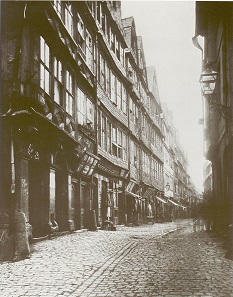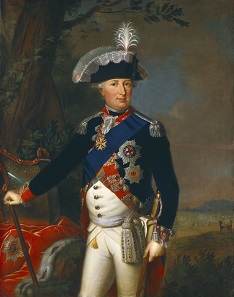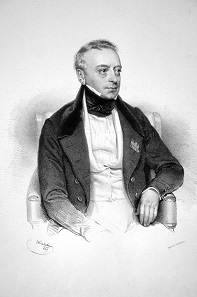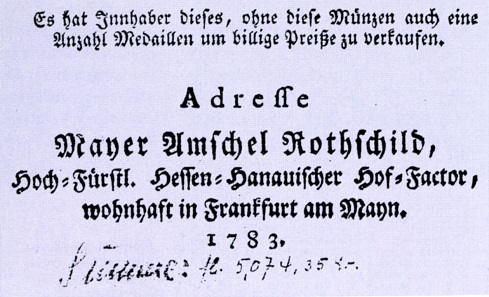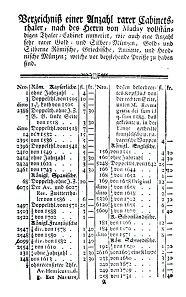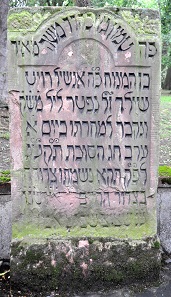translated by Christina Schlögl
On 23 February 1744 – sometimes noted as 1743 – Meyer Amschel was born as the first son and third child of Amschel Moses’ and Schönche Rothschild’s five children in the Jewish ghetto of Frankfurt.
Judengasse, formerly the Jewish ghetto in Frankfurt on the Main ca. 1868. Photo: Th. Creifeld.
Just like his father and his grandfather had done, he learnt the traits of salesman and moneychanger as a boy. At the time, these were typical occupations of Jewish people, who were not allowed to do various other jobs. But it was already in 1755 that his father died and a year later, his mother died as well. As a consequence, the five little Rothschilds had to rely on the support of family and friends.
Meyer Amschel got lucky. He was accepted as an apprentice at the renowned Hanover banking house Oppenheimer. There he learnt all dealings and businesses, a “court factor” would do. Court factors were the irreplaceable aids of Baroque princely courts. They were independent businessmen who were responsible for the purchase of all goods, especially luxury goods of all sorts. For the most part they also handled art trade, since decorating the court with paintings of famous painters and creating impressive coin collections was part of the “bon ton” at every court. This was actually pretty good business but there was also a high risk. The function of creditor and agent for fund raising was tied to the function of court factor. The state tax system was only in the early stages and the state coffers were often empty. Thus a vendor of luxury goods often had to have a lot of staying power until he would get the advanced money back. On the other hand, the title “court factor” was quite useful to impress the untitled customers; no wonder that Meyer Amschel-Rothschild later figured as “Princely Hesse-Hanau court factor, residing in Frankfurt on the Main”.
One of Meyer Amschel Rothschild’s customers was William, hereditary prince of Hesse-Kassel. Painting by Carl Gustaf Pilo.
In Hanover, Meyer Amschel Rothschild got to meet Emmerich Otto August von Estorff (1722-1796). This famous military officer was an experienced coin collector in his leisure time and he passed on a lot of knowledge to young Meyer Amschel. The apprentice in turn provided the collector with numerous rare coins. He probably realised very early on that there is no quicker way to win an influential coin collector’s heart than to get him new coins.
It was through General Estorff that Meyer Amschel made the acquaintance of the hereditary prince of Hesse-Kassel, later William I. Soon William also regularly bought coins from the zealous coin dealer. A first bill amounting to 38 gulden and 30 crowns was made in June 1765.
As newly minted court factor, Meyer Amschel Rothschild could marry his neighbour Gutle Schnapper. Portrait of Moritz Daniel Oppenheim from 1836.
At this point, Meyer Amschel Rothschild had probably already started his own business with a coin dealership and bureau de change in Frankfurt. He was highly successful. Only five years later, he was made court factor of William of Hesse-Hanau at the young age of 25. This did not only make him a man of great renown but it also won him a spouse. He married Gutle Schnapper, who only lived a few doors down. She brought 2,400 gulden worth of dowry into the marriage and she would later give him five sons and five daughters.
Salomon Mayer Freiherr von Rothschild founded the Austrian branch of the Rothschild bank empire. lithograph by Josef Kriehuber 1839.
Meyer Amschel’s five sons later took over the five Rothschild banking houses in Frankfurt, London, Vienna, Naples and Paris.
“Das Haus zum grünen Schild” (the green shield house), the original company building of the Rothschilds since 1784 or 1786.
Business was going well in these early years. Despite the fact that court factors could theoretically work in different lines of business, Meyer Amschel appears to have specialised in dealing with coins, medals and antiques. A business address register from the city of Frankfurt from 1778 lists him as dealer of “antiques, medals and show pieces”. At the time, there could not have been many coins dealers doing transregional business. At least, as far as we know, Rothschild appears to be the only one in Frankfurt. Some of his customers lived really far way, so that Meyer Amschel often had to travel to visit them and buy coin collections from them.
He annually issued a small sales catalogue in octavo format, some of which we still have today. They contain coins which were not estimated according to their precious metal content but according to their historic value instead. The most commonly used reference was the “Talerkabinett” of David Samuel Madai.
Coin catalogue 1783, last page.
Business was constantly expanding. While the six older ones of the preserved catalogues from the 1770s mostly contained talers to a total value of 1,666 to 2,917 gulden, the four younger catalogues from the 1780s also feature Greek and Roman silver and gold coins, as well as “ancient and pagan” coins. The total volume had also risen. Customers were now provided with 2,579 to 5,074 gulden worth of material. This supply probably also entailed different – most likely ancient – art objects. A catalogue from 1783 or 1784 reads: “I also sell a number of ancient cut figures and stones, precious little pictures, some of them diamonded; if a connoisseur should want to look at them, they will be sent and the cheapest price will be determined.”
The stock must have been very big, since it took years until it was noticed that Meyer Amschel’s servant, Hersch Liebmann, had been stealing from his master for years. The charge from the year 1796 lists more than 200 gold and silver coins with an estimated value of roughly 2,000 gulden. No wonder than the servant had been seduced by the sight of all this money: His was annual salary only 30 gulden.
Front page of the Meyer Amschel Rothschild coin catalogue, probably from 1785.
We can reconstruct how Rothschild’s coin dealership was operating from accounts of a transaction in 1789. At the time, the prince-elector Karl Theodor bought a series of coins. First, the objects were sent to him for viewing purposes. Then the customer would negotiate the price for the objects he wanted to keep. The rest was sent back to the coin dealer. As you can see, this was a veritable mail order business and these services were not only provided to the princes, but also to the non-titled coin collectors, as long who could afford it. Unfortunately, no documents on these transactions have survived, as most private collectors did not keep a complete record of their purchases.
It is not unlikely that there also were auctions, probably during the Frankfurt fair, which lured a lot of customers into the city.
Gravestone of Meyer Amschel Rothschild in the Jewish cemetery of Frankfurt on the Main. Photo: Genealogist / CC BY-SA 3.0.
In any case, the dedicated coin dealer cultivated excellent contacts to important people. During these years, he got a reputation as a reliable partner for princely courts. Meyer Amschel Rothschild’s communication network should function as the base for the rise of the Rothschild dynasty, which would become one of the most influential European banking houses in the 19th century, but this is a whole other story.



